
- Sails & Canvas
- Hull & Structure
- Maintenance
- Sailing Stories
- Sailing Tips
- Boat Reviews
- Book Reviews
- Boats for Sale
- Post a Boat for Sale
- The Dogwatch
- Subscriptions
- Back Issues
- Article Collections
- Free for Sailors
Select Page

Charley Morgan and the Fiberglass Factory
Posted by Daniel Spurr | Sailing , Sailor Profile
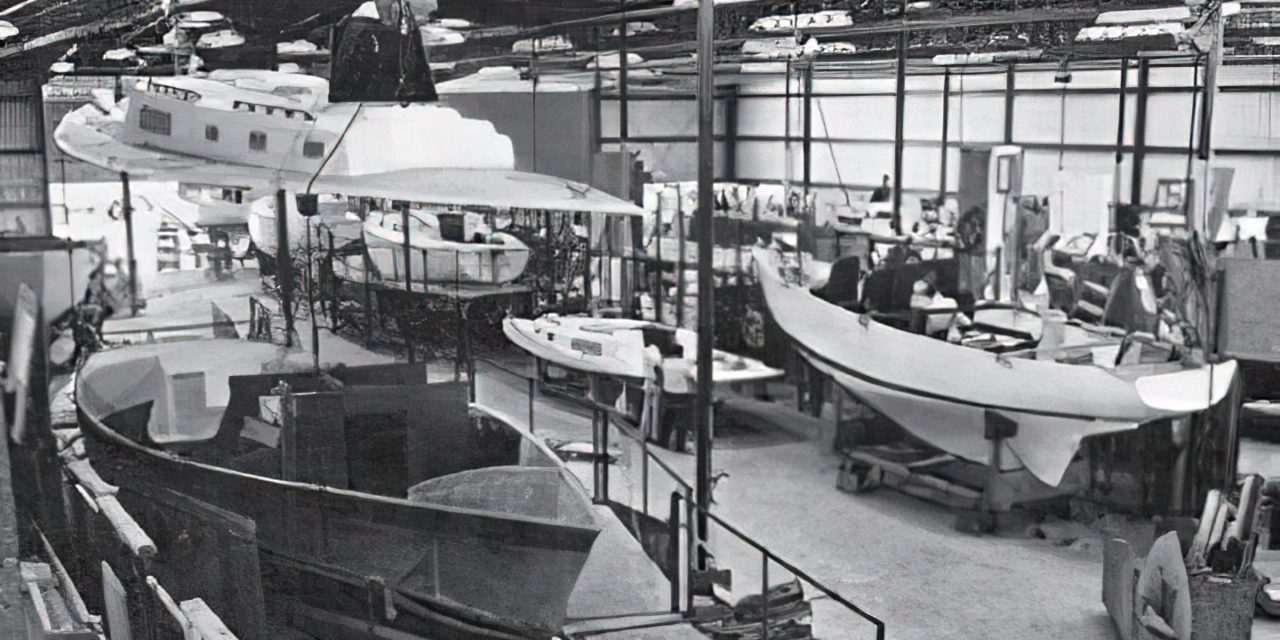
Charley Morgan — 1929-2023
Sailing legend Charles E. Morgan (Charley to his friends, which was just about everyone) passed away January 6, 2023 on Treasure Island, Florida, at the age of 93, mere hours after the passing of his wife Maurine.
The following Good Old Boat article that I wrote in 2005 tells the high-points of Charley’s illustrious career but, he deserves emphasis for a few of the most notable:
- Longtime designer, builder of custom and production sailboats, and sailmaker.
- Probably the only person in the long and storied history of the America’s Cup to design, finance, build, skipper, and make the sails for a Cup boat — Heritage .
- Winner of two SORC (Southern Ocean Racing Conference) events in boats he designed, built, and skippered (1961 and 1962).
- Revolutionized the Caribbean charter trade with the Morgan Out Island 41, of which more than 1,000 were built.
And a genuinely good guy. RIP, Charley.
– Dan Spurr
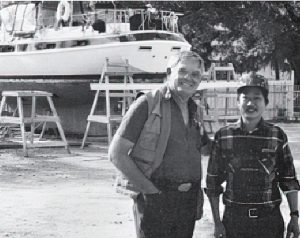
Charley Morgan, left, with Paul Benfield, owner of the Tibbets Boatyard. Behind them is a Morgan Out Island 51.
He found the best way to win was to build his own boats
Florida, like California, with its eternally warm weather and friendly skies, is a natural place in which to build boats — and was especially so back in the early days of fiberglass when hulls were cured outdoors using sunlight as the catalyst. A cheap labor pool also was available. Boatbuilders sprang up on both Florida coasts — in Miami and in the Tampa-St. Petersburg area. Many are still there, not on the water where real estate is too expensive but — as in Costa Mesa, California, the Mecca of 1960s fiberglass boatbuilding in this country — inland, back in the dusty, nondescript industrial zones next-door to plumbing and building supplies.
Charles Morgan, born November 17, 1929, in Chicago, now a yacht designer and consultant, hasn’t built a sailboat in many years, but during the late 1960s and through the 1970s he was a formidable force in the exploding fiberglass sailboat industry. He was the designer of Heritage , a 1970 America’s Cup 12-Meter; the designer and builder of Paper Tiger , winner of the prestigious Southern Ocean Racing Circuit (SORC); a production boatbuilder of Morgan Yachts; and an independent designer and consultant. He’s done it all.
Aeronautical engineer
Charley Morgan grew up on the west coast of Florida messing about in boats and went to college close to home, first to Valencia Junior College in Orlando and then to the University of Tampa, where he planned on being an aeronautical engineer. Following graduation he worked a short time for a telephone company before getting sidetracked by sailing.
“I went queer for boats,” he says, explaining why he took a job at Johnson Sails in Tampa and then opened his own loft, Morgan Racing Sails, in 1952 in St. Petersburg.
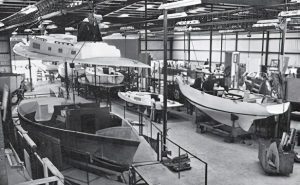
At Morgan Yachts’ St. Petersburg, Florida, facility, men worked from scaffolding on boats of all sizes. Note how the decks were moved and positioned from overhead beams.
Rust, shatter, and rot
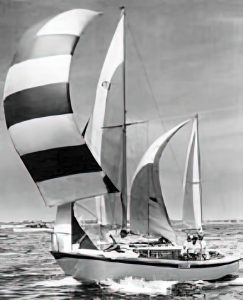
Charley Morgan’s first boat, Brisote. Demonstrating considerable resourcefulness, she had a Star Boat keel and rudder, a Thistle mainsail, and a modi- fied Penguin sail for a mizzen.
Charley built the hull and deck himself, with help from a young aerospace engineer named John Mills. Charley recalls stopping by the local yacht club one day after finishing work at the shop. “The old savants were sitting in the club, and I came in with resin all over me. One of the guys said, ‘I under- stand it’s got a steel backbone, wooden decks, and a fiberglass hull; you know, it’s gonna rust, shatter, and rot.’ ”
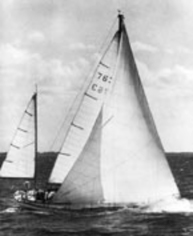
Paper Tiger was perhaps Charley’s most famous design. She won the SORC for two consecutive years, in 1961 and 1962.
Clark Mills, designer of the International Optimist Pram and the Windmill, finished Paper Tiger for Jack Powell, for whom Charley had designed her. But at first Clark was skeptical. When Charley showed him the boat, Clark hooked his thumbs in his pockets, chewed on his stogie, cocked his head, and said, “Well darn- it, I’ve built boats from scratch, kits . . . you name it. But this is the first time someone’s brought me a coat of paint and asked me to build a boat inside it.”
History will not forget what that “coat of paint” accomplished. In an unprecedented feat, Paper Tiger twice took overall SORC honors in 1961 and 1962.
Charley next designed the 28-foot Tiger Cub and began looking for a builder. The search proved futile, so he did the only logical thing he could — he formed Morgan Yachts and built them himself. They were all essentially one-offs, that is, they were not built from the same reusable mold.
The Tiger Cub later became the Columbia 31, but that didn’t happen until after Dick Valdes and Vince Lazzara put Charley’s 40- foot Sabre into production as the Columbia 40, a generous move by Vince which was intended to help Charley launch his own business.
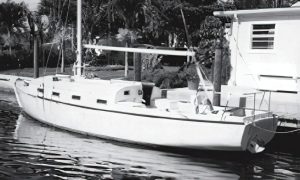
The one-off Rare Aves, the first fiberglass boat Charley ever saw, inspired him to build Paper Tiger out of the same new material. Rare Aves still sails today from her home port in the Florida Keys.
Lost the Circuit
The speedy centerboarder had nearly won the 1964 SORC and looked to be a good bet for the general market. “We won the Nassau Race and the Lauderdale Race,” Charley lamented years later, “and still lost the Circuit, if that’s possible.”
Also that year he built what he says was then the world’s largest fiberglass sailboat, the 60-foot Maredea , whose hull form was tank tested. The result: first place in the St. Petersburg-to-Venice, Florida, race.
In 1965 business was so good the company temporarily stopped taking orders. They were building a wide range of boats, from the $995 Wind- mill to a $44,900 45-footer. Gross that year was $1.7 million. Unlike a lot of builders, Charley handled finances well, once remarking, “Nothing leaves that driveway out there unless and until it’s paid for.”
Charley’s childhood friend, Bruce Bidwell, joined him that year and together they introduced the Morgan 34, which the ads described as “an immediately successful racer/cruiser and an attractive, beamy, keel-centerboarder, CCA-style yacht . . . for families for whom yachting is a way of life.”
The Cruising Club of America (CCA) rule attempted to encourage designs that would be safe, comfortable family cruisers as well as decent performers on the racecourse. Notable features included short waterlines (the long overhangs would immerse when heeled to increase sailing length beyond the measured length), large mainsails and small foretriangles (partly because big multispeed winches hadn’t been developed yet). These boats were often yawls because the mizzen staysail was essentially unpenalized by the rating rule. A lot of them were centerboarders because shoal draft was important in Charley’s native waters of south Florida.
Smaller wetted surface
In the Morgan 24, the rudder was separated from the keel-centerboard — a major step forward in yacht design. Charley wasn’t the first to do this, but the Morgan 24’s racing record helped to validate the idea. Not only did the emergence of the fin keel help the boat turn more quickly in prestart maneuvers, it also greatly reduced wetted surface area, which meant less friction and, therefore, faster speeds.
The Morgan 24 is still a good performer by today’s standards, with moderate displacement and shoal draft. And — priced around $5,000 — it’s a terrific value for anyone looking for a boat in this size range.
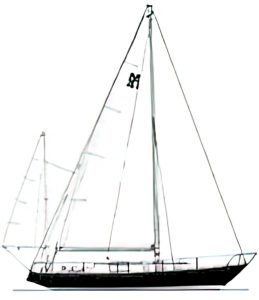
Morgan 41 Illustration
Other boats to follow included the Morgan 30, 41, and 45, which later was built as the Starrett & Jenks 45. But it was the development of the Out Island series — 28, 33, 36, 41, and 51 — that gave the company a big burst of business.
Charley’s interest in racing never waned, though, and he continued to de- sign and build custom boats. One was Rage , which he, with Halsey Herreshoff as navigator, took to second place in the 1968 Newport-to-Bermuda race.
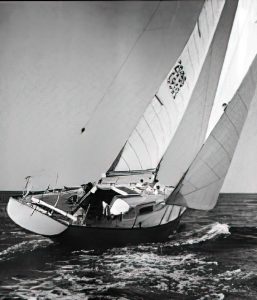
The Out Island series
“The Morgan Out Island 41,” Charley says, “was the extension of a long study period, where we tried to create a commodious and comfortable tri-cabin arrangement. In 1970 we finally got it worked out — human engineering and ergonomics. We designed and aimed it at cruisers as well as the charter-boat market. We sought input from a lot of companies big and small, including the Moorings and Jack Van Ost [a dentist who became a successful builder of CSY boats for his charter business].
“The boat was designed to compete with the boats being put out by Gulfstar, which were for a new market that Vince Lazzara [who by now had left Columbia in California and started Gulfstar in Florida] had perceived. Our dealers had requested for a long time a boat without a centerboard that was shoal with lots of room; it didn’t need to sail like a rocket. It came out at the Annapolis Boat Show and was an instant sellout. We built, in the first calendar year, over $4 million worth — 120 units. Eventually we built those boats on two lines, with them coming off the combined lines one a day. They number in excess of 1,000.”
In all, Morgan Yachts built more than 40 different production models, beginning with Charley’s trademark centerboarders, the Out Islands, the Henry Scheel-designed 45/46 (originally built by another builder as the Scheel 45), and a number of boats designed to the International Offshore Rule (IOR), including the Morgan 33 ¾-Ton and Morgan 36 One-Ton. Sailing Kit Craft made a number of designs avail- able in kit form because, as Charley says, “there were so many people who wanted to get a hold of one of our boats who couldn’t afford a finished boat.” But along with a handful of other 1970s builders, such as Islander and Columbia, Morgan Yachts dropped the practice because many owner-completed boats were poorly finished, reflecting adversely on the manufacturer.
Retirement day
Charley remembers well the day he retired. It was June 6, 1972, he recalls with certainty. It was easy to see that divorcing himself from the company he’d created was a watershed in his career . . . and life. He’d merged the company into Beatrice Foods four years earlier (1968) and had stayed on as chairman of Morgan Yacht Corporation. But for Charley, like many people, working for a large corporation was difficult after he had been in business for himself.
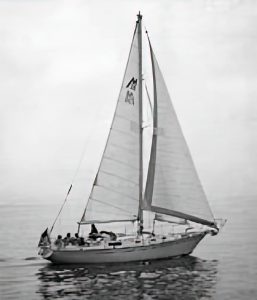
Later, Beatrice Foods sold Morgan Yachts to Thor Industries. Subsequently, in 1984 it was passed along to Frank Butler and Catalina Yachts, which continued to build the Morgan 38 and the Out Island 41 (Classic 41) for a number of years before finally putting them to bed.
Of Morgan Yachts’ many accomplishments, one that makes Charley positively beam is the boats he built for Disney World long before it got into the cruise business. “There was a time we built the largest fiberglass boats in the world,” he said. “Morgan Yachts designed and built the principal original watercraft for Disney World, a whole fleet of them, the largest of which is around 120 feet — sub- marines, the jungle cruise boats, the steam launches. In all, more than a hundred. It’s exciting the way you can completely create out of glass some- thing that looks like wood; on the submarines we faked the scales and rivets. We created an incredible theatrical appearance for Disney.”
Charley also designed motor yachts such as the West Indian 36, a hover- craft, and Heritage , the last wooden American 12-Meter ( France II was the last in wood among all nations). Alas, Heritage lost to Intrepid in the 1970 defender trials.
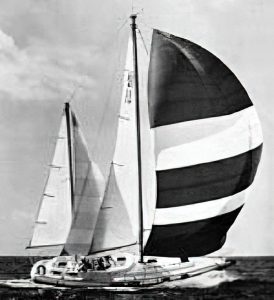
Between 1971 and 1984 more than 1,000 Morgan Out Island 41s were built. Later, after Catalina Yachts acquired some Morgan molds, the 41 was resurrected with minor modifications and sold as the Morgan Classic 41.
Way of measuring
Cindy Goebels, reporting in Southwinds magazine, said Charley ex- plained his interest in the America’s Cup thus: “It’s all just another way of measuring yourself. Competitive men always want to know how big they are in relation to others, how they can perform. Dollars are a way of keeping score. There may be other means in a more mature society. Why this? Well, there’s damn little you can justify out- side of wanting to keep on breathing.” Charley Morgan was always a good interview, seldom mincing words.
Morgan Yachts’ St. Petersburg facilities were considered modern and first-class. “We maintained a laboratory and did a lot of outside testing,” Charley says. “We were using balsa cores from the beginning. Later I was a great proponent of Airex. Then came Divinycell, Klegecell, carbon fibers, Kevlar, and the utilization of high- modulus materials. Way back in 1965 and 1966 we were researching work done in the aircraft and aerospace industry. But those materials had no place in yacht building in those days because lightness was not the key- note; the economic issues were more important . . . and the ability to have readily available resources.”
Charley likes to talk about how the advent of fiberglass changed the face of American boating. “You didn’t have to be an extremely wealthy person to think about owning a boat,” he says. “The concept of the non-wasting asset. You could treat ’em and deal ’em like automobiles. You had an orderly market and the burgeoning charter boat and used-boat market. It just altered completely the brokerage firms. Back in the days after the end of World War II, you could count on your fingers the brokerage firms: S&S, Northrop & Johnson. Bang, bang, in one fell swoop, the tides changed and ripped over us.
Dramatic change
“The thing that kept coming through to me was the dramatic change that was made by fiberglass and the huge opportunity given to the American boater.
“Look at the Ensenada Race – all the ones going down to Mexico – huge clusters of boats! In the Great Lakes, the Mackinac Race had a few entries before the war, but bang! At the end of the war they started getting some fiberglass boats on the scene – my word! — you’re looking at 100-boat fleets or better. It made a major change for Americans who wanted to become part of sailing and yachting. Our ad used to say, ‘The past decade’s most exciting new construction medium.’ How prophetic those words were.
“What sort of disturbs me these days is when they tag the sailing boat people as elitist. I like to say that they’re really more dedicated and enthusiastic about their sport and therefore have organized it more so it has the appearance of elitism.
“The only boats I’ve seen break up are some racing boats that were really lightly built, crossing the Stream or something. I’ve traced a few of those stories about boats splitting in two – bull! I’m sure there are some examples, but the truth is that fiberglass is marvelous.”
And of the strength and longevity of fiberglass?
“I hate to tell you how quickly a wooden boat goes down. We crossed the finish line down in Sarasota after getting chewed up in a nor’wester at the crack of dawn. We could see the committee boat in the murk, saw her lights and the farewell marker at Sarasota Pass. We went zooming by, struck the chute and mizzen staysail, jibed over, cranked up the engine, cleaned up the forward deck and started banging through the slop up toward the pass. Dawn had come. I looked up and yelled, ‘Hey, look! There’s some spreaders sticking up out of the water.’ The committee boat broke its line, blew up on the bar, popped like a cantaloupe, and went straight to the bot- tom. Pieces floating; heads bobbing around and lifejackets. She went down that fast. You kidding me?
“Yet I saw a whole night when [the fiberglass sailboat] Inferno sat over on the bricks at Lucaya [Grand Bahama] banging and slamming and scream- ing and moaning on those bricks. My heart was going out to that boat . . . the sea bursting over her. Three days later I saw her hauled out at Spencer’s in Palm Beach, and I went over and got up inside the boat, looked at the keel – gnawed up a little bit. Not bad!”
Another company
Guys like Charley Morgan are never really retired, even though they sometimes think they are. In 1975 he started yet another boatbuilding company, the Heritage Yacht Corporation. Perhaps anticipating the trend toward power, this time he built both fiberglass sailboats and trawler motoryachts. That venture wasn’t as financially successful, however, and he was forced to seek protection from creditors under Chapter 11 of the federal bankruptcy code. Subsequently, in the early ’80s he served for a short time on staff at Chris-Craft, while the remaining assets of Heritage went to Catalina, which had also bought Morgan Yachts from Thor Industries.
Today, Charley keeps a design studio in his home. Recent projects include two long-range motoryachts, one steel, the other aluminum, by Top- per Hermanson. But, he says, new de- sign commissions have fallen off considerably since 9/11. He says, “I’d love to do a full-powered steel auxiliary for the right person. Totally self-sufficient with watermakers, air-conditioning, whatever they want.” Like a lot of other people in the industry, he sees his aging followers taking an interest in the comforts of motoryachts, but not all want to go to sea without some sort of stick overhead.
To fill his time, Charley is teaching himself painting, taking after, in a reverse sort of way, his son and daughter, who are both artists.
And, of course, he still finds time for sailing. He was active in the local Star fleet until his wife became ill six years ago; he nursed her until her death in February 2001.
But, he says, he’ll do his yacht club’s Mexico race this year, and there’s always the Morgan Invasion, a rendezvous for owners, in which he participates.
Last October, the 19th annual Invasion was held at the Treasure Island Tennis and Yacht Club in Treasure Island, Florida. The event coincided with Charley’s 75th birthday. More than 100 boats participated. Nothing makes a designer or builder happier than seeing his boats still going strong and his owners happy. One of his favorites, Paper Tiger , recently resurfaced in the West Indies,” he says with pride. “And she’s till honkin’.”
So, too, one might add, is Charley Morgan.
Note: This article is a revised version of information included in Heart of Glass: Fiberglass Boats and the Men Who Made Them , by Dan Spurr.
About The Author
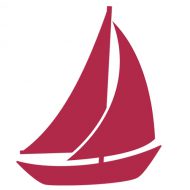
Daniel Spurr
Dan Spurr is a contributing editor with Good Old Boat and editor-at-large with Professional Boatbuilder. He is the author of seven books on boats and sailing and was formerly senior editor at Cruising World and the editor of Practical Sailor.
Related Posts

Vigor’s Black Box Theory
July 17, 2019

American Ninja Warrior Liveaboard
January 16, 1999
Travels with Mystic
July 1, 2013

The Joy of Sextant
September 1, 2019
Current Edition
Join Our Mailing List
Get the best sailing news, boat project how-tos and more delivered to your inbox.
You have Successfully Subscribed!
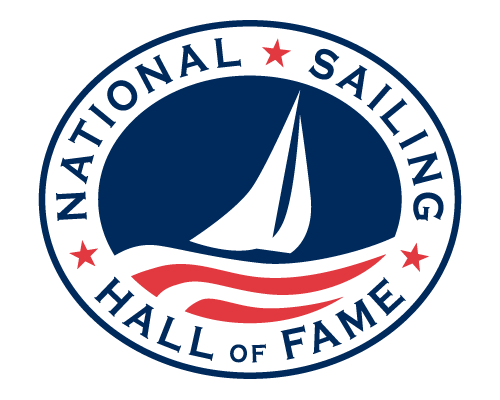
All Inductees > Class of 2023
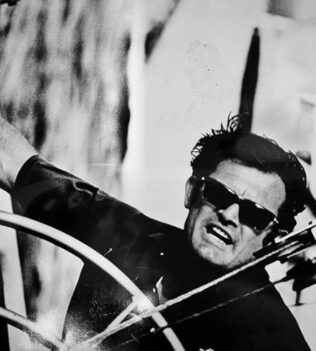
Charles Eugene "Charley" Morgan Jr.
November 17, 1929 - January 6, 2023
Chicago, Illinois
There are many words to describe Charles E. Morgan, Jr. — enthusiastic, inquisitive, industrious, and friendly are a few that come to mind. Charley, as he was known around the waterfronts of the world, enjoyed a long career making sails, flying airplanes, designing and building boats, racing for the America’s Cup, creating artwork, making exhibits for Disney World, and working as an expert on handicap rating rules.
After attending the University of Tampa, he worked at Johnson Sailmakers for a brief time before starting his own loft in 1952 at the age of 23, Morgan Racing Sails. He focused on small one-design yachts like Stars, Thistles, and Snipes. To help sell his sails he competed at a high level. Charley Morgan won the Star Class North American Championship and many other regattas. He was a sought-after crew on larger boats and became fascinated with finding ways to improve boat speed. In 1955 he teamed up with Charlie Hunt to design and build a 32-foot hard-chine yawl. The hull was coated with a new material called fiberglass. The boat won several races, and they built more boats. In 1960, Morgan had a breakthrough when he was commissioned by Jack Powell to build a 40-foot, centerboard yawl named “Paper Tiger.” The boat won the Southern Ocean Racing Conference in 1961 and again in 1962. Capitalizing on the success of his racing boats, Morgan founded the Morgan Yacht Corporation with partner Bruce Bidwell. The company’s order book was filled with racing and cruising yachts ranging from 24 to 54 feet in overall length. Many of the 1,000+ Morgan Out Island series cruising yachts are still on the water today.
Morgan sold his company to Beatrice Foods in 1968 and used the funds to mount an America’s Cup campaign. He designed, built, made the sails, managed, and skippered Heritage in the 1970 America’s Cup Defense Trials. The 12 Meter boat was too large to put on a trailer to transport it over the road to Newport, R.I. so Morgan and his crew sailed the boat from Florida to Rhode Island. The boat was built out of wood and coated in varnish. Heritage was a beautiful yacht but did not make the cut losing to Intrepid. Critics wrote that Charley Morgan had tried to manage too many tasks to be successful. Still, he was a popular character that Cup summer.
Morgan built several watercraft for Disney World including Mark Twain’s river boat and the 20,000 Leagues Under the Sea submarine. In his later years he studied art by traveling to Europe to study master works. He took courses and lessons on how to be a better artist. In 2018 a large sculpture of the frames of a sailboat hull was placed along the Riverwalk in Tampa. The title of the work is “Paying Homage to Charley.”
Gary Jobson
Preserving America’s Sailing Legacy
Engaging Sailing’s Next Generation
Stay Connected to the National Sailing Hall of Fame

Professional BoatBuilder Magazine
Charley morgan 1929 -2023.
By Dan Spurr , Apr 10, 2023

Charley Morgan steers his 12 Meter Heritage on Narragansett Bay. He liked to wear vests with big pockets, probably to hold all the big ideas he had.
A bright, kindly bear of a man who seemed like he might live forever finally gave up the good fight on January 6, at age 93, reportedly just hours after the passing of his second wife, Maurine. Timing is everything and Charley, as he was affectionately known by just about everyone, seemingly aced it even at the end.
His timing for entering mass production of fiberglass boats was also excellent. He founded Morgan Yachts in 1962 with a 28′(8.5m) sloop called the Tiger Cub. Aided by Dick Valdez and Vince Lazzara—who at the same time were running Columbia Yachts in California, and who purchased the plans to the Tiger Cub (which became the Columbia 31) and Morgan’s 38 (11.6m) Sabre (which became the Columbia 40)—Morgan kept a watchful eye on their success, particularly on the business end, and more specifically development of a dealer network akin to the auto industry. Key to the growth of both companies, Morgan told me years ago, was that unlike wooden boats, which he termed a “wasting asset,” banks were willing to finance fiberglass boats, which enabled the middle class to become yacht owners. To support his dealer network, Morgan worked with banks to “floor plan” dealer inventories. Emulating another aspect of the automobile industry, Charley’s first wife, Sally, collected car brochures and used them as a guide for their own promotional literature, substituting key words like “yacht” for “automobile” and “icebox” or “locker” for “trunk.”
There are still hundreds if not thousands of Morgan yachts afloat in all corners of the U.S. and around the world, which will make the name familiar to a young generation of sailors. In total, Morgan produced more than 40 models. The look of a 1968 Morgan 41 (12.5m) today, pretty as she is with low sweeping sheer and graceful overhangs, belies the layered story, Charley’s story, that fills in behind her and the thousands of other boats bearing his name.
Charley Morgan’s Impact on the Industry
Though born in Chicago, Illinois, Morgan grew up on the west coast of Florida and attended the University of Tampa, where he majored in economics and pre-engineering. A man who loved words and always seemed to search for a clever and precise way to say something, he liked to quote one of his professors, who told the class, “There is no economic advantage that cannot be duplicated or nullified.” Those became Charley’s watchwords.
He built model airplanes as a kid, and got a pilot’s license, but during World War II something shifted, and in Charley’s words, he “went queer for boats.” He fell in love with sailing and recognized that speed is a combination of hullform, construction, and sails. So, after graduating in 1951 he moved to St. Petersburg and opened Morgan Yacht Sails in an airport hangar. With no time for formal education in naval architecture, he soon taught himself the other ingredients in the recipe for speed—design and boatbuilding skills.
In 1956 he commenced his first build, the 31′ (9.4m) Brisote , constructed of plywood, with a scavenged Star-class keel, a Thistle mainsail, and a modified Penguin mizzen sail. He took third in fleet and second in class in that year’s St. Petersburg-to-Havana race. Encouraged, he designed and built the 40′ Paper Tiger with a steel backbone, fiberglass skin, and wood decks. Pundits at his St. Petersburg Yacht Club mused that it would “rust, shatter, and rot.” What it did do was win the SORC (Southern Ocean Racing Circuit) in 1961 and ’62, a damn impressive start to anyone’s career.
Charley’s successes caught the attention of yachting’s elite, and in 1962 he was invited to crew on the 12-Meter Columbia for the America’s Cup trials in Newport, Rhode Island. “I was in the cockpit with Glit Shields [Cornelius Shields Jr.] steering and Olin Stephens navigating,” he said. “Olin took me under his wing, and we had a lot of good conversations. Olin was so generous…without giving away business.”

The 12-Meter Heritage—designed and built by Morgan, who also skippered her in America’s Cup trials—cruises at sunset on Narragansett Bay.
Eight years later, in 1970, Charley decided to have a go at the Cup with his own boat, embarking on a project never done before or since: designing, financing, building, and skippering a 12-Meter. Oh, and he built the sails, too. Heritage was sailed from Florida to Newport on her own bottom. During trials she had a few noteworthy wins but did not perform well enough to earn the right to defend. Heritage , the last American 12 to be built of wood, still sails Narragansett Bay as one of several Cup veterans operating as day charters.
During the heyday of Morgan Yachts in the 1970s Charley built what was at the time a modern production boat facility, with several model lines moving simultaneously, with chain falls and gantries to move hulls and decks, and scaffolding to elevate crew. Their capabilities landed contracts with Disney World to build all its large fiberglass structures for the new amusement park in Orlando, including a 120′ (37m) submarine ride and jungle cruise boats. At the time, Charley believed the sub was the largest fiberglass structure in the world.
In 1968 Charley thought about going public with a stock offering but instead was enticed by the Beatrice Foods conglomerate to sell, staying on for four years. In 1984 Catalina Yachts bought Morgan Yachts, mainly to obtain an East Coast manufacturing facility, and to get the tooling for the hugely popular center-cockpit Out Island 41, which helped popularize the bareboat charter industry in the Caribbean.
After Morgan Yachts, Charley says he retired but not really, trying his hand at designing trawlers and expert witness work. He and wife Maurine took up painting, and the last time I visited their Treasure Island home Charley was packing one of his works for donation to a local charity. He spent hours with me aiding my research for Heart of Glass , the history of fiberglass boatbuilding, because he loved boats, loved the industry, and felt it was important that the pioneers be remembered and properly acknowledged.
And because it was his nature to always give more than he got.
Read more Design , Obituary , People/Profiles , Rovings articles

- Departures: Carl Chamberlin
Passionate, competent, considerate, modest, and thoughtful is how designer and boatbuilder Carl Chamberlin is remembered by those who knew him. He died last November at age of 75 in Port… Read more »

SAFE Boats Regains Small-Business Status with Employee Ownership
More than 20 years ago, Professional BoatBuilder ran a feature titled “God, Country and Fast Boats” (No. 85, page 64) about SAFE Boats International (SBI), a Bremerton, Washington–based manufacturer of aluminum boats…. Read more »

SNAME Powerboat Symposium Is Back
The Society of Naval Architects and Marine Engineers (SNAME) Technical and Research Program, in cooperation with the Hampton Roads, Virginia Section of SNAME, will host the Sixth Annual Powerboat Symposium… Read more »

Recent Posts
- There was Only One Partner I’d Trust for the Refurb Project of my Life: AkzoNobel
- Citimarine Store Expands to a New State of the Art Location in Miami
- Find out how 3D printing can help your boatbuilding with MASSIVIT
- Van der Werff’s Curved Wood
- Companies (85)
- Construction (106)
- Design (161)
- Drawing Board (10)
- Education (25)
- Environment (16)
- Events (21)
- Materials (50)
- Obituary (18)
- People/Profiles (49)
- Products (16)
- Propulsion Systems (32)
- Racing (16)
- Repair (37)
- Rovings (317)
- Short Cuts (3)
- Sponsored Partner News (16)
- Systems (80)
- Task Sheet (1)
- Uncategorized (26)
- Wood to Glass (7)
ProBoat.com Archives

Published on January 9th, 2023 | by Editor
Eight Bells: Charles Morgan
Published on January 9th, 2023 by Editor -->
Charles Morgan, (November 17, 1929-January 6, 2023), an icon in the world of sailing from the late 1940s, passed away at 93 years. His passing came just hours after his beloved wife Maurine had died.
Charley was born in Chicago in 1929 but grew up in Tampa, FL. He was a boy when his uncle took him sailing on Lake Conway near a sleepy town called Orlando. At 10 he built his first sailboat out of discarded orange crates and sack cloth.
He attended the University of Tampa and took a job with Johnson Sails. In 1952 he founded Morgan Racing Sails in Tampa, FL. While making sails, he met yacht designer George Luzier, who got him interested in designing boats. In 1960 Jack Powell commissioned him to build the 40 foot centerboard fiberglass yawl PAPER TIGER.
The famously successful Paper Tiger won the SORC Southern Ocean Racing Conference in 1961 and 1962. Because of that triumph, his prior success building racing sails, and a newly developed relationship with legendary yacht designer Olin Stephens; Morgan Racing Sails received an order to build some sails in 1962 for the Stephens-designed America’s Cup defender Columbia.

Unable to find a builder to manufacture the Tiger Cub, a smaller version of Paper Tiger, he founded the Morgan Yacht Corporation in 1962. Early models included the Tiger Cub and fiberglass sloop Morgan 34. The Morgan Yachts line of boats quickly grew to a fleet of sizes from 22′ to 54′ Morgan Marauder. In 1968, he sold his company, which increased his wealth substantially, but continued to design and help with the company.
Charley’s interest turned to the 1970 America’s Cup where he designed, built, and skippered his 12 Meter Heritage, which was launched May 3, 1970. He even sailed the boat on its own bottom from St. Petersburg, Florida to Newport, Rhode Island.
There were four 12 Meters competing for the America’s Cup defense in 1970: Weatherly (12 Meter US-17), Intrepid (12 Meter US-22), Heritage (12 Meter US-23), and Valiant (12 Meter US-24). Heritage started the trials off well with a win over Weatherly but was later knocked out of the trials by Intrepid.
In response to customer feedback while operating Morgan Yacht, he designed the shallow draft Morgan Out Island 41. One of the most popular boats over 40 feet overall ever built. First built in 1971 the spacious boat became popular with charter companies, becoming “the standard charter boat. Charlie left Morgan Yachts in 1972.
He found Heritage Yacht Corporation in 1975, producing trawlers and sailing yachts. He later worked for Chris-Craft, doing design work on their trawler line. He designed sailboats in the 60s for Columbia Yachts including the Columbia 40 and Columbia 38 as well as other yacht builders and private clients. Later in the 70s till the early 90s, he also designed for other manufacturers including the Com-Pac 35 for Hutchins Yachts.
Sailmaker, racing sailor, yacht designer, boat builder, and America’s Cup designer and competitor; Charley was accomplished in all aspects of sailing and was truly a sailing legend.

Tags: Charles Morgan , Eight Bells
Related Posts
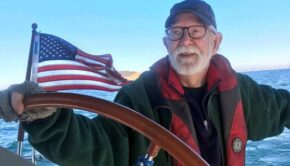
Eight Bells: Ed Huntsman →
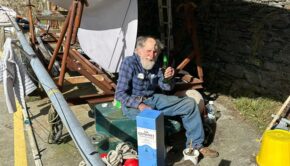
Eight Bells: Donald Street, Jr. →
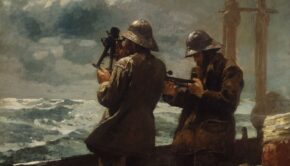
Eight Bells: Linda Merkle →
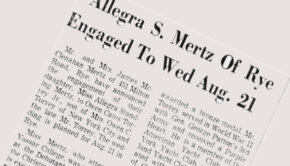
Eight Bells: Allegra Mertz Torrey →
© 2024 Scuttlebutt Sailing News. Inbox Communications, Inc. All Rights Reserved. made by VSSL Agency .
- Privacy Statement
- Advertise With Us
Get Your Sailing News Fix!
Your download by email.
- Your Name...
- Your Email... *
- Comments This field is for validation purposes and should be left unchanged.

- Life & Culture
For sailboat designer Charley Morgan, life's still a breeze
- Times Staff Writer
Charley Morgan, who calls himself "the ancient mariner," felt like a kid again. Eighty-five candles will grace his next birthday cake, but when he noticed the palm trees swaying beyond the window, he marched outside to look at Boca Ciega Bay. Standing on his dock, he saw Blue Cloud prancing at the end of a rope like a rambunctious colt wanting to leap the corral fence.
"Let's go sailing," Morgan said.
He took hold of the tiller. Tim Horsman, his stepson and owner of the 24-footer, unfurled the sails. Catching the wind, Blue Cloud bolted toward open water. Seconds later, she — Morgan observes the traditions — was slicing through waves fast enough to lean over. The old man grinned.
"We're honking along."
He felt like a rambunctious colt himself. A year ago, he felt older than his age. He saw blood in his urine. He needed a nap after breakfast. A high-energy optimist by nature, he wondered if his friends might soon be reading about him — in the obituaries.
"Let's get the jib up," he yelled to his stepson, who raised the forward sail.
In his younger days, Morgan was among the world's premier designers of sailboats, fancy ones for millionaires and modest ones like Blue Cloud. Self-taught, in 1960 he built Paper Tiger for famous New York yachtsman Jack Powell. In 1965 he founded Morgan Yachts, the company that made him famous. He was a renowned sailor as well, competing in the Southern Ocean Racing Circuit and sailing's most celebrated event, the America's Cup. He was so aggressive at the tiller, a competitor once said, that Morgan wouldn't have let his mother win even an insignificant race. Fortunately, Mom didn't sail.
In 1968, Morgan sold his company and became an exceedingly wealthy man. Then he designed a 12-meter wooden boat for himself, Heritage , to race in America's Cup trials in 1970. He didn't advance, though Heritage won other races elsewhere. His masterpiece is still in use in Newport, R.I., to raise money for charity. Sometimes Morgan sits on his couch in Treasure Island with a legal pad and redesigns Heritage for fun. With tweaking, the still-driven Morgan is sure it could be faster.
"Charley isn't the type of person who is going to just sit there and relax," his wife, Maurine, always tells friends. "He always has something going.''
He was born in Chicago in 1929 but grew up in Tampa. He was a boy when his uncle took him sailing on Lake Conway near a sleepy town called Orlando. At 10 he built his first sailboat out of discarded orange crates and sack cloth.
Professionally built sailboats were a rare sight during the World War II era in Tampa Bay. He never saw more than eight at once. Sometimes he got a loaner and sailed to St. Petersburg. At 19 his confident parents let him sail on a boat called the Red Bird — to Havana.
The adventurous boy also was enamored by the romance of deep-sea diving. During the childhood summers he spent with relatives on Florida's Indian River, he built his underwater helmets out of tin buckets. "Kid, you're going to drown," yelled his uncle, hauling him from the water.
Explore Tampa Bay’s sights and bites
Subscribe to our free Do & Dine newsletter
You’re all signed up!
Want more of our free, weekly newsletters in your inbox? Let’s get started.
"It was a different world," Morgan says. "So different from today's Florida. The old-timers ate turtles and turtle eggs. My aunt and uncle drank their water from a cistern — except for the time a cat drowned in it."
The future sailboat designer to millionaires made root beer money by catching toadfish on a cane pole and selling them as crab bait for a nickel a pound. His Cracker kin ate so many mullet their stomachs fluctuated with the tide.
At the University of Tampa, Morgan tried focusing on engineering. Then a sailing friend enlisted him in a sailmaking operation. Morgan quit college and opened a sail shop on the St. Petersburg waterfront. Sailmaking led to Morgan Yachts. His best-known sailboats ranged from 24 to 54 feet. He even built the submarines Disney World used in its 20,000 Leagues Under the Sea ride.
As a businessman, his credo was "You don't get your boat until I get my money." Even now he subscribes to the Harvard Business Review.
"Luff up," he yelled to his stepson, who arranged the sails.
Blue Cloud headed into the wind, bucking like a bronco, though not enough to affect Morgan's delicate equilibrium. His thousands of nautical miles over the decades have included many spent retching over the side. How does he manage? Throw up and focus on what's important. On one voyage to Cuba, a sail split in a storm and he came inches from being lost at sea.
In 1956, he met Sally Crawford, who did all their marketing. Their marriage lasted until her death from cancer in 2001. In Europe he spent months grieving and looking at art masterpieces. Perhaps because he is Charley Morgan, he wondered about reinventing himself as an artist. After all, he had enjoying drawing as a kid.
He studied, took lessons from Tarpon Springs maestro Christopher Still, painted like a maniac. In 2006 he married Maurine Horsman, an artist who paints on one side of the Florida room while on the other side he works on a painting inspired by seeing a panther near the St. Johns River when he was a boy.
His bookshelf is lined with art books and volumes about sailing and design. He likes nothing more than discussing the engineering involved in boat building, using the word "theorem" or mentioning "the propagation of gravity waves" or puzzling over the "vorticity in trailing eddies" that slow otherwise fast sailboats.
"Charley Morgan is a vibrant young man who is so tense with ideas, thoughts, philosophies, ambitions and self-improvement projects that on a clear, quiet night you can almost hear him hum as though he were a human generator, which, indeed, he seems to be." The late sailing writer Red Marston published that elegant sentence in the St. Petersburg Times more than a half-century ago.
A little more than a year ago he saw blood in the toilet bowl. Doctors were puzzled about his urine. Bewilderment frustrates Charley Morgan. Tell him what's wrong and how it can be fixed.
At the Moffitt Cancer Center, he got an answer. There was a tumor on a kidney. Doctors removed the kidney. He rested, felt weak, got stronger. Weeks and months passed. He started painting, started looking out the windows at Blue Cloud .
She is not the Heritage , and Boca Ciega Bay is not the North Atlantic. His days of sailing in the America's Cup are long behind him.
It didn't matter.
Out on the bay, the old man grinned and brought her home.
Contact Jeff Klinkenberg at [email protected] or (727) 893-8727. Follow @jeffklinkenberg.
MORE FOR YOU
- Advertisement
ONLY AVAILABLE FOR SUBSCRIBERS
The Tampa Bay Times e-Newspaper is a digital replica of the printed paper seven days a week that is available to read on desktop, mobile, and our app for subscribers only. To enjoy the e-Newspaper every day, please subscribe.
- New Sailboats
- Sailboats 21-30ft
- Sailboats 31-35ft
- Sailboats 36-40ft
- Sailboats Over 40ft
- Sailboats Under 21feet
- used_sailboats
- Apps and Computer Programs
- Communications
- Fishfinders
- Handheld Electronics
- Plotters MFDS Rradar
- Wind, Speed & Depth Instruments
- Anchoring Mooring
- Running Rigging
- Sails Canvas
- Standing Rigging
- Diesel Engines
- Off Grid Energy
- Cleaning Waxing
- DIY Projects
- Repair, Tools & Materials
- Spare Parts
- Tools & Gadgets
- Cabin Comfort
- Ventilation
- Footwear Apparel
- Foul Weather Gear
- Mailport & PS Advisor
- Inside Practical Sailor Blog
- Activate My Web Access
- Reset Password
- Customer Service

- Free Newsletter

Pearson Rhodes 41/Rhodes Bounty II Used Sailboat Review

Hallberg Rassy 42 Used Sailboat Review

How to Perform Your Own Pre-Buy Inspection

Beneteau 323 Used Boat Review

How Does the Gulf Stream Influence our Weather?

Can You Run a Marine Air-Conditioner on Battery Power?

Preparing Yourself for Solo Sailing

Your New Feature-Packed VHF Radio

Practical Sailor Classic: The Load on Your Rode

Anchor Rodes for Smaller Sailboats

Ground Tackle Inspection Tips

Shoe Goo II Excels for Quick Sail Repairs

What Oil Analysis Reveals About Your Engine

An Unusual Sailboat Shines a Light On A Sustainable Future

Is It Time to Get an Electric Dinghy Motor?

Bottom Paint 30-Month Update

Battle of the Teak Cleaners — Snappy Teak-Nu vs. Star Brite

New Seacocks for the Offshore Sailor

Bottom Paint Care


Are E-bikes Worth the Extra Weight and Cost?

How to Handle the Head

How to Select Crew for a Passage or Delivery

Preparing A Boat to Sail Solo

Re-sealing the Seams on Waterproof Fabrics

Waxing and Polishing Your Boat

Reducing Engine Room Noise

Tricks and Tips to Forming Do-it-yourself Rigging Terminals

Marine Toilet Maintenance Tips

Learning to Live with Plastic Boat Bits
- Sailboat Reviews
Morgan 24/25
She's fast and roomy, but plagued by centerboard problems that are tough to avoid..
Back in 1965, a St. Petersburg, Florida sailmaker named Charlie Morgan, who had been dab bling with custom racing yacht design and had come up with a remarkable string of winners, started producing a series of small- to medium-sized production boats. Introduced late that year, the Morgan 24 joined the Morgan 30, 34 and 38, becoming an instant success as a fast cruiser and club racer.
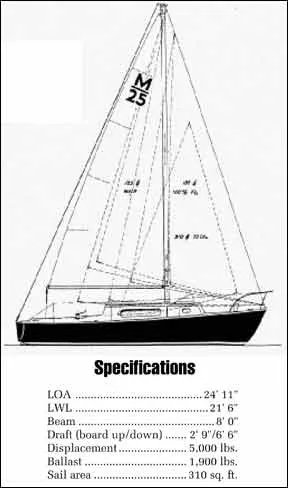
Morgan 24/25 specifications
In 1968 the Morgan Yacht Corporation was bought by the conglomerate, Beatrice Foods, and by early 1969 the Morgan 24 had been renamed the Morgan 25, with some changes in specifications and options. For example, although the actual length overall remained at 24′ 11-3/4″, the advertised length moved from 24′ 11″ to 25′ 0″; inboard diesel and gasoline engine options were offered in addition to outboard power; toerails switched from teak to molded fiberglass; and the transom outboard cutout was eliminated in favor of an optional outboard bracket.
Morgan Yachts was later resold to Thor Industries and most recently to Catalina Yachts. After about 1972 more changes were made. The hull-deck connection went from through-bolted to pop-riveted; rigging blocks were downsized; window frames were changed from silver anodized aluminum to black plastic; the water tank changed from stainless steel (Monel in the early boats) to galvanized. The last Morgan 25s were built in 1976. Over the years, between 400 and 500 were built.
The Morgan 24/25s long waterline, very well balanced hull, relatively low wetted surface, large sailplan (for its vintage), and attention to small details like well-shaped foil blades and flush-faced through-hulls, provide good speed and close-winded sailing for the racer. At the same time, its shallow draft (2′ 9″ board up) and relatively roomy layout below appeal to the cruising sailor.
The boat has firm bilges to help with form stability, and a reasonable 5,000 pounds of displacement. However, with ballast placed relatively high due to the shallowness of its keel, the Morgan 24/25 is a bit on the tender side in heavy air.
The cockpit is eight feet long, but underway it comfortably seats just two on each side of a long (4-1/2′) low tiller that extends within 22 inches of the companionway. In a race, the third and fourth crew, if any, have to move from cockpit to cabintop, due to crowding and because the boat tends to get stern-heavy with crew weight aft. Because of this, serious racers tend to remove the outboard engine from the transom and stow it below, if rules permit.
The cockpit sole slopes aft to a single centerline scupper through the transom, and this works satisfactorily except for a puddle of water that gathers on the leeward side in rain, and except for the smallish scupper size (1-1/4″ diameter), which some owners have enlarged for faster drainage.
The base M/24 was offered as a relatively bare cruising version, with small (#2) South Coast sheet winches, end-boom sheeting without a traveler, short genoa tracks along the toerails, and no spinnaker gear. An extra-cost optional racing package included spinnaker gear, #3 genoa winches, longer genoa track, six extra cleats, two extra genoa cars, boom vang, snatch blocks, and traveler. Other extras included stainless bow pulpit, lifelines and stanchions, interior and running lights, and compass. The factory-installed options were fairly expensive, with the result that many sailors bought the base version and added equipment themselves. That, plus the fact that M/24s were available at one point as kits, may account for the wide variation in quality, style, and placement of equipment.
Construction
As one owner puts it, only slightly mixing metaphors, The Morgan is a Chevrolet, not a Hinckley. For the most part, owners mention defects in passing but on the whole are very satisfied. One says his forward V-berth bulkhead came loose and had to be refastened, but also reports that fiberglass work is generally neat and strong.

Most boats came off the line with faucet-type gate valves on the through-hulls; many owners report replacing them with more suitable barrel or ball valves.
On the older 24s with teak toerails, the deck is fastened to the hull along a wide L-shaped flange with 1/4-inch stainless bolts on 2-inch centers, with every other bolt passing through both teak and fiberglass-a very strong arrangement. But on the newer 25s, the teak rail was eliminated and the joint fastened with pop rivets, a weaker system that is more likely to leak.
Common problems on both 24s and 25s include leaky windows and crazed Plexiglas; a mast hinge that is virtually useless due to lack of provision for preventing side sway when lowering or raising the mast; dissatisfaction with the dated appearance of the simulated wood-grain mica bulkhead finish, which requires major effort to remove and replace; and centerboard difficulties.
The centerboard pennant arrangement is probably the weakest design detail on the boat. The board itself is a well-shaped, high-aspect ratio, solid fiberglass unit in a trunk beneath the cabin sole. The 1/8-inch stainless steel pennant wire attaches at one end of a groove molded into the top of the board, winds its way via a stainless steel piston through a stuffing box to a turning sheave forward, then through two more sheaves an to a small winch mounted on the cockpit wall. Several problems can arise due to this design. The lower portion of the pennant, being exposed to seawater, tends to corrode rapidly, and is impossible to inspect without complete disassembly. Hence frequent inspection, requiring a haul-out or scuba gear, is advised. In southern waters, some pennants have failed in less than a year of service. Additionally, several owners report trouble with cracking and leaking in the short stub of hose that bridges the stuffing box and trunk. And unless the owner adds stops at both its ends, the piston can part company with the stuffing box and possibly sink the boat.
Other centerboard-related problems: The turning sheave, under the sole forward of the trunk, is almost inaccessible; owners are well advised to cut an access hole and lubricate the sheave frequently to minimize corrosion. And on some boards, insufficient glass reinforcement around the pin can result in eventual cracking or breakage of the board at the pin hole.
The 24s and 25s at various times were made with two different interior arrangements: (1) a dinette model with a single sail locker to port, and (2) a two-quarterberth model with twin sail lockers. The dinette version has less space for sail stowage, and there is a considerable amount of wasted space under the starboard cockpit seat unless an access hole is cut in the plywood bulkhead aft of the quarterberth (which is often done). For cruising, however, the dinette model wins hands down, given the greater storage space in the galley and a hanging locker, better privacy inherent in the position of the offset head, and a sizable table for dining or laying out charts. Sitting at the dinette is uncomfortable for four people due to the deck overhanging the outboard seats. In all, most agree that the 24/25 is really a two-sleeper, two-eater vessel.
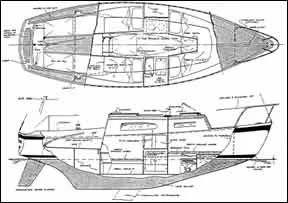
Morgan 24/25 Plans
Still, the boat has practically all the interior conveniences one could want in a small cruiser, including galley, sink, ice chest, marine toilet in a private compartment, good sized berths, long self-bailing cockpit with at least one sail locker, and 5′ 8″ headroom.
The sixtyish interior aesthetics are not great and vary with model year. In 1965 the Morgan brochure says mahogany interior trim but by 1967 the standard interior was bulkheads… paneled in woodgrained mica, with oiled American Walnut trim. Carpeted cabin sole was standard, with a teak sole optional.
A common complaint among owners is that there is no good place to store a portable gas tank. The usual place is in the cabin, aft of the companionway ladder, but that can be a source of annoying-and dangerous-fumes. A 6-gallon tank can be wedged between the cockpit seats, but limits footroom and movement around the cockpit, and the extra weight in the cockpit does nothing to help performance.
Other complaints include the fact that the icebox drain runs into the bilge, providing a source of potential odors; and that ventilation is only so-so. A cowl vent fitted on the foredeck, plus a mushroom vent over the forward hatch, are recommended additions.
Performance
The long, deep board helps the 24/25 to point high, and its low wetted surface, especially with board up, gives extra speed on reaches and runs. The boat performs best in 5 to 15 knots of breeze, but can handle much higher winds when properly reefed, though several owners reported that the boat could be a bit stiffer.
The 24/25 is unusually well balanced, and in ordinary weather can be made to self-steer on a beat or close reach with tiller lashed. However, in very heavy air carrying a chute, it has a marked tendency to broach.
A typical PHRF rating is 219, compared to a J/24 at 171 and a Cape Dory 25 at 261.
Pride of ownership seems particularly evident among owners of the early M/24s, who tend to turn up their noses at the later M/25 as a less sturdy and well-appointed boat. Over the years, both models, and particularly kit boats, are likely to have had major changes to equipment and rigging, some good, some bad. Consequently, prospective buyers should check to be sure any such modifications are appropriate, and should keep in mind that these boats are now 18 to 28 years old, so should be closely inspected for gear that can fail due to aging. Most such gear is repairable, but at a cost. Still, if you find one on which extensive work isn’t necessary, it can be a real bargain as well as a real pleasure to own and use.
In 1972 the Morgan 25 had a base price of $7,495. Earlier models in reasonable condition can be had today for about $5,000, more depending on sail inventories end equipment. Inboard models of the 25 are higher yet, though we feel the outboard model is a better choice.
The Morgan 24/25 makes a wonderful small cruiser and club racer, and can be a solid value if you buy the right boat. Construction quality has varied over the years, and so has quality and quantity of equipment purchased by individual owners. Moreover, all 24s and 25s, even the good ones, are beginning to show their age. Buyers are advised to make a careful inspection to be sure they’re not getting a boat with more problems than they care to handle.
RELATED ARTICLES MORE FROM AUTHOR
Leave a reply cancel reply.
Log in to leave a comment
Latest Videos
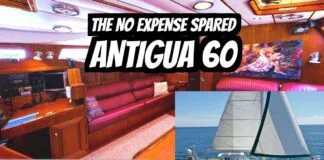
The No Expense Spared Antigua 60 Cruising Sailboat Soolaimon

How To Buy Sails – With Joe Cooper

Bavaria C42: What You Should Know | Boat Tour

Universal Diesel Engines – What You Should Know
- Privacy Policy
- Do Not Sell My Personal Information
- Online Account Activation
- Privacy Manager
Olson’s Classic Yachts
Enjoy the freedom of sailing well-equipped cruising yachts, without the cost and maintenance hassle of private ownership., paper tiger – morgan 42.
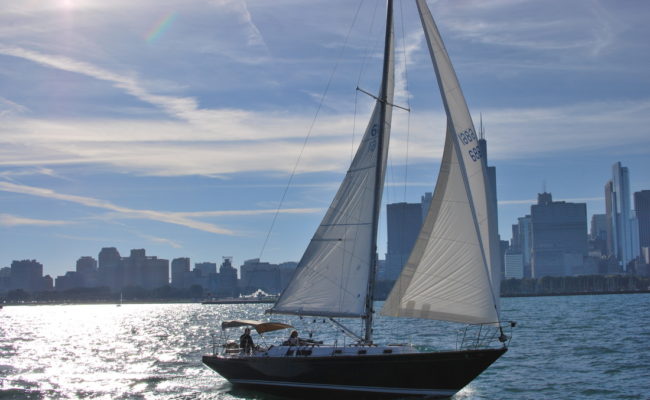
Naval architect, ocean racer and yacht builder Charlie Morgan launched his career with back-to-back wins racing his own design 42-foot yawl in Southern Ocean Racing Circuit competition. Forming Morgan Yachts he used his racing experience to design fast bluewater cruisers for a line which quickly became one of the most popular of the era.
Our Morgan 42 is a production sloop version of his original yawl design. Prior to our acquisition, Paper Tiger was harbored her entire life at West Basin Marina in St. Joseph, Michigan, a popular haven for other classic Morgan sloops. Owned in recent years by a former Morgan Yachts worker, she has cruised Lake Michigan extensively, was raced regularly and successfully in local and southern Lake Michigan yacht club races, and has been a frequent competitor in the annual Chicago-to-Mackinac race.
Renamed in honor of Morgan’s own yacht in her transition to our fleet, Paper Tiger is unmistakably Charlie Morgan - seaworthy and fast with eye-turning lines: low freeboard, bow and stern overhangs and sweeping graceful sheer. Easy to fall in love with, a signature element of her allure, as with other Charlie Morgan originals, is architectural honesty. Her elegant beauty is a direct result of her core sailing function.
Paper Tiger offers space and speed advantages over smaller boats. When you bring guests or plan on spending time aboard, you’ll appreciate her large cockpit and spacious cabin, amply trimmed with genuine teak and brass. Getting away for a weekend cruise, you’ll be happy to have the extra speed. On your mooring or sailing Chicago waters, you’ll be surprised at the attention her emerald green hull attracts. If you have the experience, you can be her skipper!
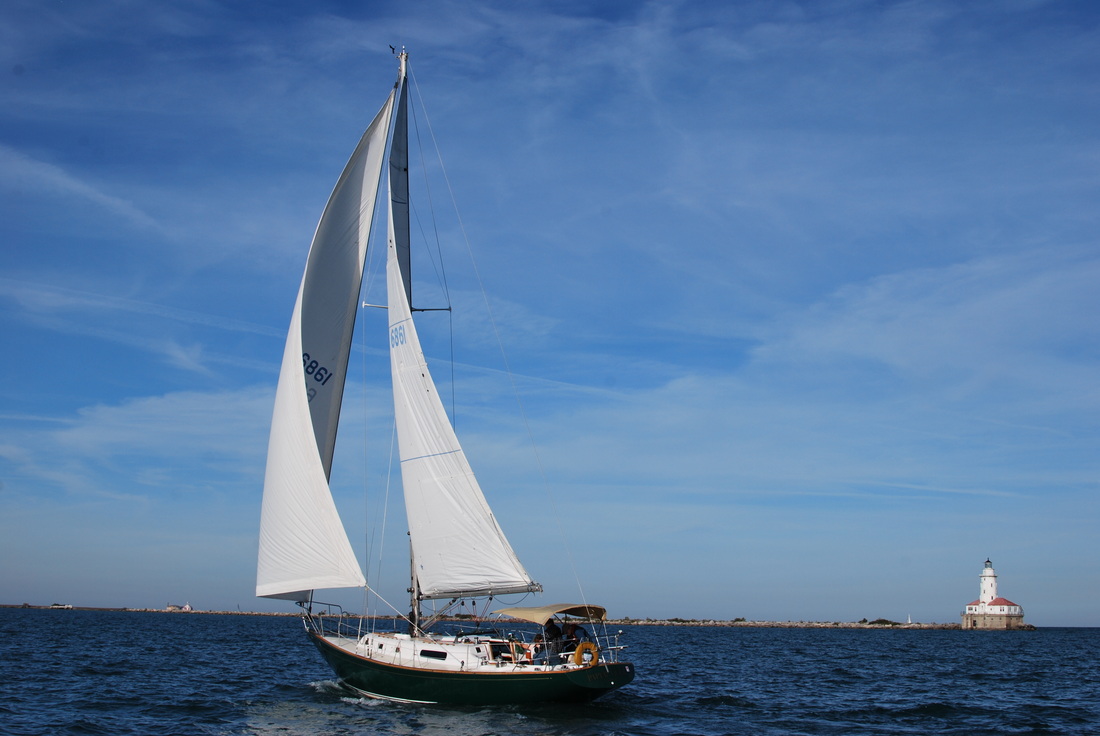
Comments are closed.
Great choice! Your favorites are temporarily saved for this session. Sign in to save them permanently, access them on any device, and receive relevant alerts.
- Sailboat Guide
Charles Morgan
Designer and builder of the famed Morgan(USA) line of sailing yachts. Charles Morgan was already well known as a designer of one particularly sucessful racer, Paper Tiger, when he started building another of his designs, the TIGER CUB, on his own. But it wasn’t until 1965 when he joined forces with long time friend, Bruce Bidwell, and began to built the sucessful MORGAN 34. This was followed, most notably, by the MORGAN 24, 30, 41, and 45. The line grew to include a great number of cruising and racing yachts. The OUT ISLAND 41, introduced in 1970, became legendary as a no-frills, center-cockpit standard, especially in the charter trade.
57 Sailboats designed by Charles Morgan

Morgan Out Island 41

Morgan 24/25

Morgan Out Island 415

Morgan Out Island 41 Classic

Columbia 31

Columbia 40

West Indies 36 (Morgan)

Columbia 38 CB

Columbia 38

Morgan Out Island 33 MS
Heritage 1 ton.

Columbia 39 Constellation
Morgan out island 49.

Morgan Out Island 28

Morgan Out Island 37/372

Morgan Out Island 33

Morgan Out Island 36
Morgan 45 (s&j).

West Indies 38 (Morgan)
Heritage super 27, morgan out island 41 ketch, morgan out island 36 ketch.

Spindrift 24
Explorer 46 (morgan).

Nautical 39
Starratt & jenks 45.

Chrysler 27
Tiger cub 28.

Melody 34 (Hunt)
Morgan 42-1.

Morgan 30-2

Morgan Out Island 30

Morgan Out Island 415 Ketch

Morgan 42-2
Morgan 40 cruising ketch.

Morgan 54 (Marauder)

Morgan Out Island 51

Morgan Out Island 416

- About Sailboat Guide
©2024 Sea Time Tech, LLC
This site is protected by reCAPTCHA and the Google Privacy Policy and Terms of Service apply.
I can do all things through Christ who strengthens me. Philippians 4:13

Charley Morgan Legacy
Charley morgan.
1 9 2 9 - 2 0 2 3
P O R R O E T S U R S U M
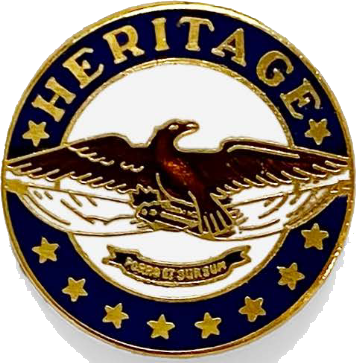
IN MEMORIAM
On Friday January 6, 2023 Charles (Charley) Morgan, Jr. passed away at the age of 93. He was preceded in death by his current wife Maurine Horsman (d. 2023), his former wife Frances (Sally) Crawford (d. 2001) and former wife Laura Marie Garrard (d. 2016). Charles (Charley) E.Morgan, Jr. born November 17, 1929, Chicago, IL to Mary Lee Morgan and Charles E. Morgan, Sr. He grew up in Tampa, Florida with his siblings, Mary Ann Morgan and John Fredrick Morgan (d. 1950). He married Laura M. Garrard in 1956 they had three children, Charles W. Morgan (d. 2019), Jennifer Morgan Holloway and John F. Morgan (Andrea Marciani). He had two grandsons Garrard Holloway and Grant Morgan and three great granddaughters Keatly Holloway, Koral and Kayla Holloway Grueser.
- Commodore Brian Smith
- MC Page Obenshain
- Bill Ballard
- Courtney Ross
- Fred Bickley
- Les Lathrop
- Don Krippendorf
Charley Morgan and his family request in lieu of flowers, please contribute to and support the St. Petersburg Yacht Club Junior Sailing program. Contact Colleen in the Executive Office at (727) 823-1061 .

HISTORY AND BODY OF WORK

To prove the concept of his theories, he began actively racing in these classes. In the Snipe class, his design efforts were rewarded with his winning the prestigious hard fought Clearwater Yacht Club Midwinter Championship 3 times (1961,1962,1964). He carried his competitive design ideas into the Star class where he won the North American Championship in 1972 and the Western Hemisphere Championship in 1974.
While crewing on larger boats, Charley became fascinated with the different relative speeds and hull shapes of various boats. In conjunction with his friend Charlie Hunt, they decided to design and build a different type of boat. The result was Brisote, a 32 foot, lightweight hard chine yawl. Built in 1955 of plywood in a Lake Wales warehouse, she was coated with the new magic material “Fiberglass", and sported a 900 pound Star keel. Brisote was raced in the 1956 St Petersburg to Havana race where she took 2nd in division. The design was completely successful and led to several later copies.

PAPER TIGER
In 1960 local businessman Jack Powell asked Charley to design a new boat to compete in the Southern Ocean Racing Conference. The result was the 40 foot fiberglass centerboard yawl - Paper Tiger. The boat was built in Clearwater, using some unique construction features, including a steel backbone for added stiffness to the hull. She was immediately successful, winning the SORC for 2 consecutive years (1961,1962). Several 28 foot Tiger Cubs were constructed locally on a custom basis. In 1962, Dick Dungan, a Palmetto sailor, commissioned a design of a 40 sloop, Sabre. (Later the Columbia 40). Sabre won the 1964 St Petersburg to Ft Lauderdale and the Miami Nassau races right out of the box.

In 1962 Charley employed sailing assistant Paul Curry, a high school student, to aid in outfitting of custom yachts. Paul continued to assist throughout Charley's custom yacht production. In 1964 Homer Denius, a former owner of Paper Tiger, commissioned Charley to design and build a world class Ocean racer - so Maredea was born. Constructed in a large shed on 4th Street South in St Petersburg, and she was beautifully finished by Courtney Ross. At the time Maredea was one of the largest fiberglass boats in the world. Years later, Maredea was donated to the U S Naval Academy. Charley was on the cutting edge of the new technology. While Maredea was being constructed, shipyard owner Jimmy Turner, had Charley design a 72 foot centerboard yawl, which was built entirely of epoxy and became Big Toy. In 1963, due to the demands of design work, Charley, together with his long time friend and sailing companion Bruce Bidwell, formed Morgan Yacht Corporation
BUILT WITH PRIDE BY THE MEN AND WOMEN OF MORGAN
One of the first priorities for Charley was the establishment of a proper design office. This included 2 young yacht designers, Jack Corey and Page Obenshain. Jack continued to lead the design team for many years. Among the first engagements for Morgan Yacht was the design and construction of 2 - 42 foot sloops, one Privateer for Sir. Eldon Trimmingham of Bermuda and Juniper for George Whitney of Massachusetts. With the proven racing success and comfortable sailing characteristics of these two boats, it was decided to venture into the production of a series of centerboard cruise/race sailboats. 34 feet appeared to be an ideal market position of sailboats at the time. It was large enough to sleep a family, small and economical enough to "be all the boat a family would need" as quoted by a local banking legend. The M34 was soon followed by the M24, M30, M27 and several other models. With the addition of the M45 and M41 models, it was became apparent that more production space was required. A nearby second plant was established, which included a separate machine shop. Charley continued to create forward looking designs, including Panacea, a 52 foot center cockpit centerboard yawl, which was designed and built for the drugstore founder, Jack Eckerd. When Panacea was completed, Homer Denius, former owner of Maredea, proposed designing and building another ocean racing boat. Charley took the challenge and spent many hours studying test tank results to achieve reduced resistance through the water. The result was Rage, a highly successful 54 foot racing machine. 1968 Saw the merger of Morgan Yacht Corporation to Beatrice Foods, a conglomerate from Nebraska. In 1969 the requirement for more production space became apparent, so a 40 acre parcel of land was purchased and developed to complete a new modern manufacturing facility.
HERITAGE - US 23
In the early 1960's Charley became intrigued with the development of the 12 Meter class. Through his close friendship with master 12 Meter designer Olin Stephens, Charley became a crew member on the12 Meter contender Columbia, during elimination trials in Newport RI. In 1968 Charley drew the lines of HIS 12 Meter. After conducting hours of test tank testing, he made the decision to build, and sail to Newport to participate in the trials for the 1970 America's cup races. This became a huge challenge - to build a large, perfect wooden boat in a fiberglass production plant. The beautiful varnished hull was finally precariously launched into Tampa Bay. and test sailed. As the hull was too large to move over the road, Heritage was sailed by a small crew up the East coast to Newport RI, which is a long dangerous voyage. Heritage was excused from the trials, after a hard and valiant Americas Cup series. An excellent 43 minute documentary "Duel In the Wind" was produced describing the races and is available for viewing online. Charley Morgan is the only person to finance, design, build, make the sails, transport and sail a boat in the America's Cup Trials.

MORGAN YACHT AND DISNEY
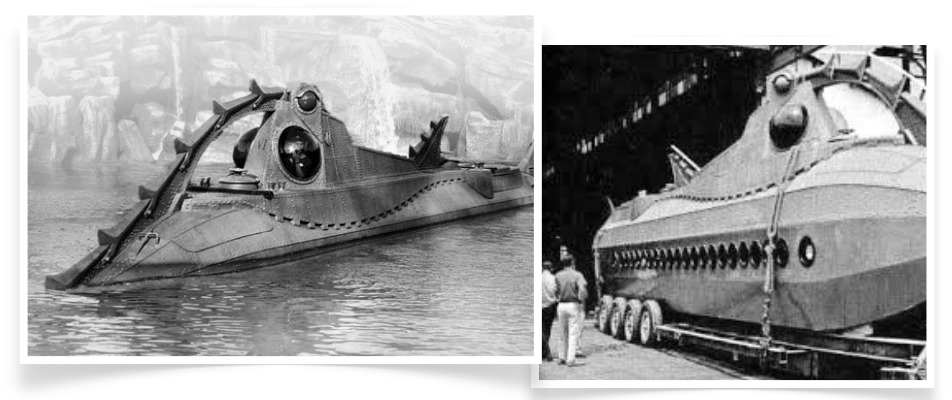
To the St. Petersburg Yacht club for your generosity and hospitality. To all friends, co-workers, and competitors. Dad loved you all. He celebrated your achievements and success, and he grieved your losses. You made his life colorful, rich and meaningful. We can’t thank you enough for your kindness. He never forgot any of you nor shall we. Godspeed Jennifer M. Holloway and John F. Morgan

Subscribe to our newsletter
- Cruising Compass Media Advertising & Rates
- Blue Water Sailing
- Multihulls Today
- Subscribe Today

Fair Winds Charlie and Maureen Morgan
At the end of a long, imaginative and exceptional life, Charlie Morgan liked to paint seascapes, yachts sailing, Tampa Bay sunsets. Charlie left us on January 9. He was above all a Renaissance man, a creator of things, boats, designs, experiences and companies. And paintings. He also liked to fly planes. And, he deeply enjoyed his old friends, friends who were not shy about loving life. Of the things he created, the earliest sign of yachting prodigy was the race boat Paper Tiger, his first design commission, which won the SORC….in dim history…two years running. That success led to many opportunities, including the Morgan Yacht Company that he sold for a life changing profit, to building America’s Cup sails for an Olin Stephens America’s Cup campaign, to an America’s Cup campaign aboard his own design Heritage. And then he went on to build truly sound cruising trawlers for the power cruising clan. But this was all a long time ago. Perhaps what will be most remembered now is the Out Island 41, and bigger sister, Out Island 51, designs that defined the early charter business in the Caribbean and set the stage for truly roomy, easy-to-sail modern cruisers. It is probably poetic that Charlie Morgan’s wife Maureen died two days before he did. Together they leave a story of lives well led that are quietly and persistently inspirational. Fair winds old friends.

Sandy Parks
You might also like.
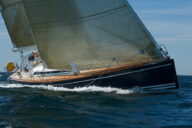
What Capacity Pumps Are Large Enough?

Sea Surface Temps at Record High: Storms Grow More Frequent and Stronger
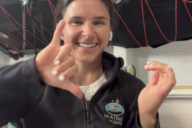
She Asked, How Hard Can It Be? Boys Do It

Read the Summer-Fall Edition of Blue Water Sailing
Read the fall 2023 edition of blue water sailing, recent posts.

- Introducing the New Wauquiez 55 Center-Cockpit Cruiser

- Orcas Strike Again Sinking 49-Foot Yacht

- Baltimore Bridge Section Blown, Deep Channel Reopens
Please Visit Our Sponsor’s Webpages

- Media Advertising & Rates
Published by Blue Water Sailing Media, a division of Day Communications, Inc., Middletown, RI
Publisher & Editor: George Day
Blue Water Sailing Media publishes Blue Water Sailing magazine, Multihulls Today and other titles.
Cruising Compass Advertising Sales:
George Day, Newport, RI [email protected] 401-847-7612
- Discovering the Galapagos Islands
- Survey of the Week
© 2014 Blue Water Media. All rights reserved. | Admin

IMAGES
VIDEO
COMMENTS
Charley E. Morgan (November 17, 1929 - January 7, 2023) was a legendary American sailboat racer and designer. He was best known as the founder of Morgan Yacht Corporation. [1] [2]
Charles Morgan, born November 17, 1929, in Chicago, now a yacht designer and consultant, hasn't built a sailboat in many years, but during the late 1960s and through the 1970s he was a formidable force in the exploding fiberglass sailboat industry. ... Of Morgan Yachts' many accomplishments, one that makes Charley positively beam is the ...
Morgan Yachts designed and built the principal original watercraft for Disney World, a whole fleet of them, the largest of which is around 120 feet—submarines, the jungle cruise boats, the steam launches. In all, more than a hundred." The total number of sailboats that Charley Morgan designed is quite impressive. Fifty-three in all.
Charles Morgan. 1929 - 2023. Designer and builder of the famed Morgan (USA) line of sailing yachts. Charles Morgan was already well known as a designer of one particularly sucessful racer, Paper Tiger, when he started building another of his designs, the TIGER CUB, on his own. But it wasn't until 1965 when he joined forces with long time friend ...
Charles Eugene Morgan Jr., 93, known to all as Charley, passed away last weekend, just a few hours after his wife Maurine died. ... In 1968, he sold Morgan Yacht Corporation to Beatrice Foods, providing funds for Morgan to design and build the wooden 12-meter yacht Heritage. He went on to found Heritage Yacht Corporation in 1975, producing ...
Charley Morgan won the Star Class North American Championship and many other regattas. He was a sought-after crew on larger boats and became fascinated with finding ways to improve boat speed. In 1955 he teamed up with Charlie Hunt to design and build a 32-foot hard-chine yawl. The hull was coated with a new material called fiberglass.
Charley Morgan 1929 -2023. By Dan Spurr, Apr 10, 2023. Charley Morgan steers his 12 Meter Heritage on Narragansett Bay. He liked to wear vests with big pockets, probably to hold all the big ideas he had. A bright, kindly bear of a man who seemed like he might live forever finally gave up the good fight on January 6, at age 93, reportedly just ...
The Morgan 38 was designed in 1969 by Charlie Morgan. He had founded Morgan Yacht Company in St. Petersburg, Florida, in 1965. The Morgan 34 was his first production model. A hometown boy, he had made a name for himself in the 1960 and 1961 Southern Ocean Racing Conference ...
Charles Morgan, (November 17, 1929-January 6, 2023), an icon in the world of sailing from the late 1940s, passed away at 93 years. ... Charlie left Morgan Yachts in 1972. He found Heritage Yacht ...
Celebrate Charley Morgan's contributions to all of the many walks of life. Sailing ~ Art ~ Community Leadership ~ Friendship ~ Philanthropy Location: St. Petersburg Yacht Club Date: February 28th, 2023 Time: 5:00 - 7:00 pm Light Snacks ~ Cash Bar RSVP at: www.spyc.org Call 727-892-6882 or click the link below: Click Here
Charles Morgan's involvement in the company ended in 1972. Since that time, the company was passed from one corporate entity to another, until it came into the hands of Catalina Yachts in 1984. Catalina continued with a few models, including the OUT ISLAND 41, before the Morgan name was retired.
For sailboat designer Charley Morgan, life's still a breeze. A self-portrait of Charley Morgan, who took up painting after his first wife died of cancer in 2001. By. Times Staff Writer. Published ...
Remembering Charles Morgan, founder of Morgan Yachts, creator of the Morgan Out Island 41, builder of floating Disney World attractions, only man to design, build, and skipper an America's Cup boat. ... Morgan Yachts designed and built the principal original watercraft for Disney World, a whole fleet of them, the largest of which is around 120 ...
In 1963, due to the demands of design work, Charley, together with his long time friend and sailing companion, Bruce Bidwell, formed Morgan Yacht Corporation. Built with pride By The Men And Women of Morgan. One of the first priorities was the establishment of a proper design office. This included 2 young yacht designers, Jack Corey and Page ...
Back in 1965, a St. Petersburg, Florida sailmaker named Charlie Morgan, who had been dab bling with custom racing yacht design and had come up with a remarkable string of winners, started producing a series of small- to medium-sized production boats. Introduced late that year, the Morgan 24 joined the Morgan 30, 34 and 38, becoming an instant ...
Paper Tiger - Morgan 42. Naval architect, ocean racer and yacht builder Charlie Morgan launched his career with back-to-back wins racing his own design 42-foot yawl in Southern Ocean Racing Circuit competition. Forming Morgan Yachts he used his racing experience to design fast bluewater cruisers for a line which quickly became one of the most ...
Morgan Out Island 416. 1981 • 12.6 m. Designer and builder of the famed Morgan (USA) line of sailing yachts. Charles Morgan was already well known as a designer of one particularly sucessful racer, Paper Tiger, when he started building another of his designs, the TIGER CUB, on his own. But it wasn't until 1965 when he joined forces wi...
On Friday January 6, 2023 Charles (Charley) Morgan, Jr. passed away at the age of 93. He was preceded in death by his current wife Maurine Horsman (d. 2023), his former wife Frances (Sally) Crawford (d. 2001) and former wife Laura Marie Garrard (d. 2016). ... Concurrently for Morgan Yacht, a demand had arisen for a large, roomy boat for the ...
Charles Morgan's involvement in the company ended in 1972. Since that time, the company was passed from one corporate entity to another, until it came into the hands of Catalina Yachts in 1984. Catalina continued with a few models, including the OUT ISLAND 41, before the Morgan name was retired. Years in Business: 1963 - 1992.
By Sandy Parks · On January 12, 2023. At the end of a long, imaginative and exceptional life, Charlie Morgan liked to paint seascapes, yachts sailing, Tampa Bay sunsets. Charlie left us on January 9. He was above all a Renaissance man, a creator of things, boats, designs, experiences and companies. And paintings.
Designer and builder of the famed Morgan(USA) line of sailing yachts. Charles Morgan was already well known as a designer of one particularly sucessful racer, Paper Tiger, when he started building another of his designs, the TIGER CUB, on his own. But it wasn't until 1965 when he joined forces with long time friend, Bruce Bidwell, and began to built the sucessful MORGAN 34. This was followed ...
Morgan Yachts (USA) Designer: Charles Morgan: KLSC Leaderboard. Auxiliary Power/Tanks (orig. equip.) Make: Universal: Type: Diesel: Fuel: 30 gals / 114 L: Accomodations. Water: ... Morgan Yachts: Download Boat Record: Notes. Available as sloop or yawl. Not to be confused with a later series of Morgan 38 footers (introduced in 1978?).
The whaleship Charles W. Morgan is the second oldest ship in America; second only to the USS Constitution. She chased whales across the globe during a profitable eighty-year career that ended in 1921. In 1941, Mystic Seaport acquired the Morgan and put her on display in Mystic, CT, where she has since welcomed over 20 million visitors.